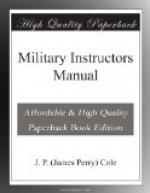After sighting and lining the sight on your sketch, step off evenly to pace the distance. Time is always a factor in military mapping and where possible make mental notes as you go along as to where roads or other important features are located, so that you can place them in their proper place on the map when you have reached the next station. It is well always to set a good pace for here time can be readily saved.
Making an intersection is very simple. For as the sketcher moves along he ties his map together by sighting at any prominent object near his area, running these lines very lightly and only where he assumes the points to lie on his map. An abbreviation on the line or a number referring to a list off to one side will answer to recall the object. At any other station where the same point can be seen a similar line is drawn and where the two lines cross will be the location of the object. In the case of three lines not crossing at the same point take the middle of the triangle so formed.
Resection is just the reverse of this process. The mapper wants to know where he is located on the map. If he is properly oriented and can aim at two points on the ground which he has located on the map, he places a pin at one of these locations on the map and aims with the alidade at the object on the ground drawing a line towards himself; this is repeated with the other known point and where the two lines cross on the map will be the point he is standing at.
In intersection the greatest accuracy is obtained by running the rays so as to meet as nearly as possible at right angles.
In running a traverse the sketcher must expect to find some error at his closing point. This error must be distributed over the whole traverse so as not to have all the error concentrated at one point.
LESSON 4. (FIELD WORK—FOUR HOURS.)
PROBLEM.—Make a simple sketch, containing topographical details using the traverse made during the preceding lesson. Use of conventional signs should be emphasized and the appreciation of features of military importance impressed. A tendency is to put in details to a point of confusion. Judgment must be developed to choose telling points.
A sharp pencil is always needed in sketching; in putting in the topographical details special attention must be given to the pencil. Keep the point sharp and make clear, distinct signs.
LESSON 5. (CLASS ROOM—FOUR HOURS.)
PROBLEM.—Contours, the Vertical Interval, Use of the Slope Board, Map Distance, Visibility and Profiles.
A contour is an imaginary line on the surface of the earth all points of which have the same elevation from a base or datum level, sea level usually being this base. Slice an apple into pieces 1/2-inch thick; where the cuts come may represent the contour lines. Take these individual slices, beginning at the bottom and outline them on a sheet of paper with a pencil (having run a nail through the apple first to keep each piece in place). The resulting circles will represent the apple’s outline at 1/2-inch intervals.




